第一章卤化反应
- 格式:ppt
- 大小:2.81 MB
- 文档页数:126


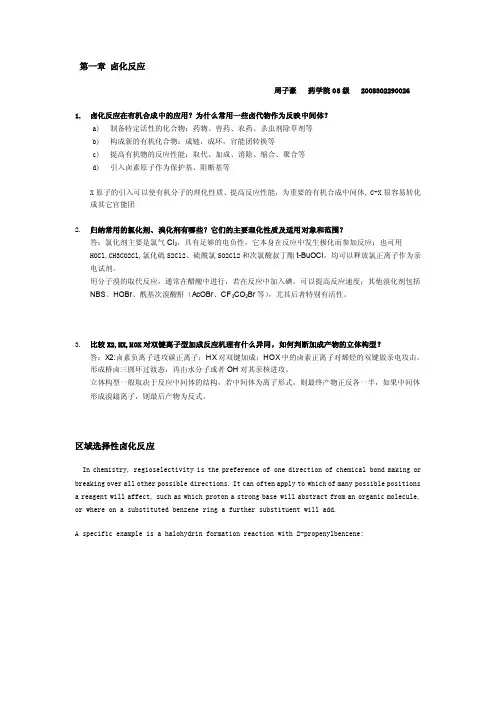
第一章卤化反应周子豪药学院08级 20083022900261.卤化反应在有机合成中的应用?为什么常用一些卤代物作为反映中间体?a)制备特定活性的化合物:药物、兽药、农药、杀虫剂除草剂等b)构成新的有机化合物:成链,成环,官能团转换等c)提高有机物的反应性能:取代、加成、消除、缩合、聚合等d)引入卤素原子作为保护基、阻断基等X原子的引入可以使有机分子的理化性质、提高反应性能,为重要的有机合成中间体, C-X很容易转化成其它官能团2.归纳常用的氯化剂、溴化剂有哪些?它们的主要理化性质及适用对象和范围?答:氯化剂主要是氯气Cl2,具有足够的电负性,它本身在反应中发生极化而参加反应;也可用HOCl,CH3CO2Cl,氯化硫S2Cl2、硫酰氯SO2Cl2和次氯酸叔丁酯t-BuOCl,均可以释放氯正离子作为亲电试剂。
用分子溴的取代反应,通常在醋酸中进行,若在反应中加入碘,可以提高反应速度;其他溴化剂包括NBS、HOBr、酰基次溴酸酐(AcOBr、CF3CO2Br等),尤其后者特别有活性。
3.比较X2,HX,HOX对双键离子型加成反应机理有什么异同,如何判断加成产物的立体构型?答:X2:卤素负离子进攻碳正离子;HX对双键加成;HOX中的卤素正离子对烯烃的双键做亲电攻击,形成桥卤三圆环过渡态,再由水分子或者OH对其亲核进攻。
立体构型一般取决于反应中间体的结构,若中间体为离子形式,则最终产物正反各一半,如果中间体形成溴鎓离子,则最后产物为反式。
区域选择性卤化反应In chemistry, regioselectivity is the preference of one direction of chemical bond making or breaking over all other possible directions. It can often apply to which of many possible positions a reagent will affect, such as which proton a strong base will abstract from an organic molecule, or where on a substituted benzene ring a further substituent will add.A specific example is a halohydrin formation reaction with 2-propenylbenzene:The reaction product is a mixture of two isomers and the regioselectivity is said to be poor.Regioselectivity in ring-closure reactions is subject to Baldwin's rules.参考文献Reactivity–selectivity principleIn chemistry the reactivity–selectivity principle or RSP states that a more reactive chemical compound or reactive intermediate is less selective in chemical reactions. In this context selectivity represents the ratio of reaction rates.This principle was generally accepted until the 1970s when too many exceptions started to appear. The principle is now considered obsolete .A classic example of perceived RSP found in older organic textbooks concerns the free radical halogenation of simple alkanes. Whereas the relatively unreactive bromine reacts with2-methylbutane predominantly to 2-bromo-2-methylbutane, the reaction with much more reactive chlorine results in a mixture of all four regioisomers.Another example of RSP can be found in the selectivity of the reaction of certain carbocations with azides and water. The very stable triphenylmethyl carbocation derived from solvolysis of the corresponding triphenylmethylchloride reacts a 100 times faster with the azide anion than with water. When the carbocation is the very reactive tertiary adamantane carbocation (as judged from diminished rate of solvolysis) this difference is only a factor of 10.Constant or inverse relationships are just as frequent. For example a group of 3- and 4-substituted pyridines in their reactivity quantified by their pKa show the same selectivity in their reactions with a group of alkylating reagents.The reason for the early success of RSP was that the experiments involved very reactive intermediates with reactivities close to kinetic diffusion control and as a result the more reactive intermediate appeared to react slower with the faster substrate.General relationships between reactivity and selectivity in chemical reactions can successfully explained by the Hammond postulate.When reactivity-selectivity relationships do exist they signify different reaction modes. In one study the reactivity of two different free radical species (A, sulfur, B carbon) towards addition to simple alkenes such as acrylonitrile, vinyl acetate and acrylamide was examined.The sulfur radical was found to be more reactive (6*108 vs. 1*107 mole-1.s-1) and less selective (selectivity ratio's 76 vs 1200) than the carbon radical. In this case the effect can be explained by extending the Bell–Evans–Polanyi principle with a factor accounting for transfer of charge from the reactants to the transition state of the reaction which can be calculated in silico:with the activation energy and the reaction enthalpy change. With the electrophilic sulfur radical the charge transfer is largest with electron-rich alkenes such as acrylonitrile but the resulting reduction in activation energy (βis negative) is offset by a reduced enthalpy. With the nucleophilic carbon radical on the other hand both enthalpy and polar effects have the same direction thus extending the activation energy range.[edit] External linksReactivity–selectivity principle Gold Book Link[edit] References1.^ Minireview The Reactivity-Selectivity Principle: An Imperishable Myth in OrganicChemistry Herbert Mayr, Armin R. Ofial Angewandte Chemie International Edition Volume 45, Issue 12 , Pages 1844 - 1854 Abstract2.^ Search for High Reactivity and Low Selectivity of Radicals toward Double Bonds: TheCase of a Tetrazole-Derived Thiyl Radical Jacques Lalevée, Xavier Allonas, and Jean Pierre Fouassier J. Org. Chem.; 2006; 71(26) pp 9723 - 9727; (Article) doi:10.1021/jo061793w3.^ Sulfur tetrazole radical derived from photolysis of disulfide and carbon radical derivedfrom photolysis of t-butylperoxide followed by proton abstraction from triethylamineElectrophilic halogenationIn organic chemistry, an electrophilic aromatic halogenation is a type of electrophilic aromatic substitution. This organic reaction is typical of aromatic compounds and a very useful method for adding substituents to an aromatic system.A few types of aromatic compounds, such as phenol, will react without a catalyst, but for typical benzene derivatives with less reactive substrates, a Lewis acid catalyst is required. Typical Lewis acid catalysts include AlCl3, FeCl3, FeBr3, and ZnCl2. These work by forming a highly electrophilic complex which attacks the benzene ring.[edit] Reaction mechanismThe reaction mechanism for chlorination of benzene is the same as bromination of benzene. Ferric bromide and ferric chloride become inactivated if they react with water, including moisture in the air. Therefore, they are generated in situ by adding iron fillings to bromine or chlorine.The mechanism for iodination is slightly different: iodine (I2) is treated with an oxidizing agent such as nitric acid to obtain the electrophilic iodine (2 I+). Unlike the other halogens, iodine does not serve as a base since it is positive. In one study the iodinization reagent is a mixture of iodine and iodic acid.[1]In another series of studies the powerful reagent obtained by using a mixture of iodine and potassium iodate dissolved in concentrated sulfuric acid was used. Here the iodinating agent is the tri-iodine cation I3+ and the base is HSO4-. In these studies both the kinetics of the reaction and the preparative conditions for the iodination of strongly deactivated compounds, such as benzoic acid and 3-nitrobenzotrifluoride, were investigated.[2][3]Halogenation of aromatic compounds differs from the halogenation of alkenes, which do not require a Lewis Acid catalyst. The formation of the arenium ion results in the temporary loss of aromaticity, which has a higher activation energy compared to carbocation formation in alkenes. In other words, alkenes are more reactive and do not need to have the Br-Br or Cl-Cl bond weakened.[edit] ScopeIf the ring contains a strongly activating substituent such as -OH, -OR or amines, a catalyst is not necessary, for example in the bromination of p-cresol:[4]However, if a catalyst is used with excess bromine, then a tribromide will be formed.Halogenation of phenols is faster in polar solvents due to the dissociation of phenol, with phenoxide ions being more susceptible to electrophilic attack as they are more electron-rich.Chlorination of toluene with chlorine without catalyst requires a polar solvent as well such as acetic acid. The ortho to para selectivity is low:[5]No reaction takes place when the solvent is replaced by tetrachloromethane. In contrast, when the reactant is 2-phenyl-ethylamine, it is possible to employ relatively apolar solvents with exclusive ortho- regioselectivity due to the intermediate formation of a chloramine making the subsequent reaction step intramolecular.The food dye erythrosine can be synthesized by iodination of another dye called fluorescein:This reaction is driven by sodium bicarbonate.[6][edit] References1.^ Regioselective iodination of hydroxylated aromatic ketones Bhagwan R. Patila, SudhakarR. Bhusarec, Rajendra P. Pawara, and Yeshwant B. Vibhute b Arkivoc 2006 (i) 104-108. Online Article2.^ The kinetics of aromatic iodination by means of the tri-iodine cation, J. Arotsky, A.C. Darby and J. B. A. Hamilton, J. Chem. Soc. B, 1968, 739 - 7423.^ Iodination and iodo-compounds Part IV, Judah Arotsky, A. Carl Darby and John B. A.Hamilton, J. Chem. Soc., Perkin Trans. 2, 1973, 595 - 5994.^ A. Sankaranarayanan and S. B. Chandalia (2006). "Process Development of the Synthesisof 3,4,5-Trimethoxytoluene". Org. Process Res. Dev. 10 (3): 487–492.doi:10.1021/op0502248.5.^ J. L. O'Connell, J. S. Simpson, P. G. Dumanski, G. W. Simpson and C. J. Easton (2006)."Aromatic chlorination of ω-phenylalkylamines and ω-phenylalkylamides in carbontetrachloride and α,α,α-trifluorotoluene". Organic & Biomolecular Chemistry 4 (14): 2716–2723. doi:10.1039/b605010g.6.^ Synthesis of Triarylmethane and Xanthene Dyes Using Electrophilic Aromatic SubstitutionReactions James V. McCullagh and Kelly A. Daggett J. Chem. Educ. 2007, 84, 1799. Abstract。
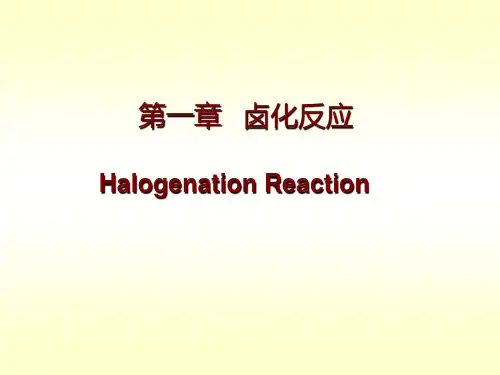
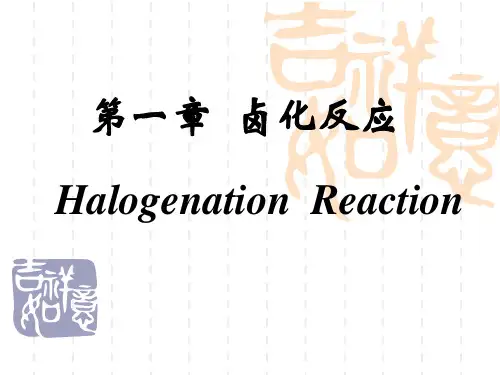
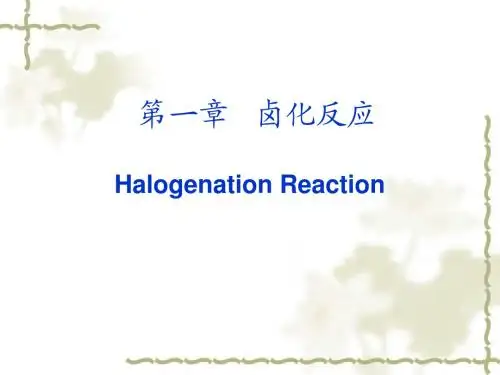
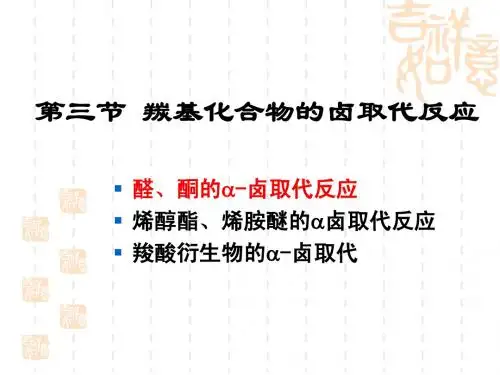

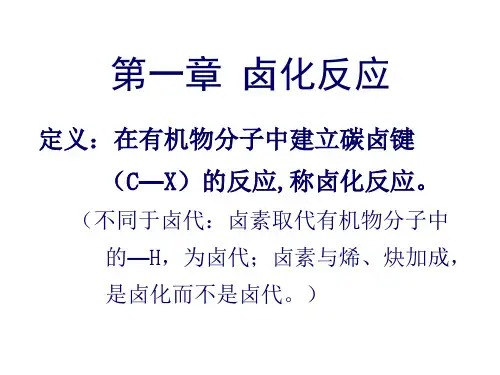
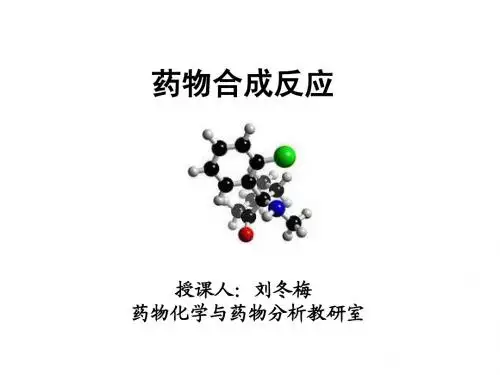
![[医学]药物合成反应第一章卤化反应-0](https://uimg.taocdn.com/7fc42647b84ae45c3b358cf9.webp)
第一章 卤化反应习题及答案1. 根据以下指定原料、试剂和反应条件,写出其合成反应的主要产物。
(1)(CH 3)2NCH 2CH 2OHSOCl 2(2)CuCl 24(3)P, Br 2o(4)CH 2CHCOOCH 3干燥 HBr 2 (5)CH 3CH 2CH 2CH 2CH 2COOHSOCl 24o(6)S CH 32266(7)H 3C CH 3NBS, H 2SO 43o(8)NHCOCH 3CH 3Br 2,CH 3COOH o(9)OHC CH 3CH 2t -BuOCl, CHCl 3o(10)NBS, (C 6H 5)3P(11)KI, H 3PO 4武汉工程大学化工与制药学院(12)C 6H 5H 3Br 2,Cl 4o (13)CH 3CH CH CH 3232(14)(CH 3)3CCH 2OHHBr(15)OOP2(16)NBS, Et 3N ·3HF 22o(17)OHBr 24o(18)O23o2. 在下列指定原料和产物的反应式中分别填入必需的化学试剂(或反应物)和反应条件。
(1)CH 3CH 2CH 2CH 2CH CHCH 3CH 3CH 2CH 2CHCHCHCH 3Br(2)COOHBr(3)(4)OHBr(5)2CH 2BrBr(6)(7)(CH 3)3CCH 2OH(CH 3)3CCH 2Br(8)OOBocHNO OBocHNBr(9)OOBr OO BrBr2. 在下列指定原料和产物的反应式中分别填入必需的化学试剂(或反应物)和反应条件。
(参考答案)题号答案注释(1) NBS/(PhCO)2O, CCl4, △(2) Br2/HgO/tetrachloroethaneNaNO2, HCl, H2O; 2. HPF6; 3. △ (168℃)(3) 1.(4) Ph3P, Br2, CH3CN, △ (200-340℃)(5) NBS/(PhCO)2O, CCl4refluxing (10min. )acetone,(6) NaI,(7) Bu3P, Br2, DMF(8) NBS/hv, CCl4(9) NBS/(PhCO)2O, CCl4, reflux3. 阅读(翻译)以下有关反应操作的原文,请在理解基础上写出:(1)此反应的完整反应式(原料、试剂和主要反应条件);(2)此反应的反应机理(历程)。
第一章卤化反应1 卤化反应在有机合成中的应用?为什么常用一些卤代物作为反应中间体?2 归纳下常用的氯化剂、溴化剂都有哪些?它们的主要理化性质及应用范围?3 根据反应历程的不同,讨论一下卤化反应的类型、机理及对反应的影响。
(1)卤素对双键的离子型加成(2)芳香环上的取代(3)方向化合物侧链上的取代(4)卤化氢对醇羟基的置换(5)NBS 的取代反应4 比较X2、HX 、HOX 对双键的离子型加成反应的机理又何异同点。
怎样判断加成方向5 在-OH 得置换反应中各种卤化剂各有何特点?他们的应用范围如何?6 预测Br2/CCl4 于下列各种烯烃进行溴化反应的相对速度的次序。
CH2=CH2 (CH3)2C=CH2 HOOC-CH=CH-COOH (CH3)2C=C(CH3)2 CH3CH2=CH2 CH2=CH-CN7 对比下列反应的条件有何不同?结合反应机理加以说明:H3C CH2 CH 2Br(1)H3C CH CH 2H3C CHBr CH 3CH 3Cl CH 3(2)CH 2ClRH 2C CH CH 2(3) R H 2C CH CH 2BrRH 2C C CH 2OH8 下列反应选用何种氯化剂为好?说明原因。
(1) H3C C CH CH3 H3CC CH CH 2BrCH 3 CH 3(2)H3 C HC CH COOH H3C HC CH COCl(3) HO (CH 2 )6 OH IH2C(CH 2)4 CH 2 OH(4) H3CCO C H 2CH 2 COOH H3 CCO CH2CHCOBrBr(5) H3 CO CH2 OHH3CO CH 2 ClH2C C (CH 2 )6 COOHCl(6)H2 C HC (CH 2)6 COOHBr H2C (CH 2)6 COOHCOOHCOOHCOCl(7)Cl Cl HO OHNCl Cl NNCOClHO OHN9 完成下列反应,写出主要的试剂及反应条件:OHOH(1)COOH COClCH 3 CF3(2)(3) CH3COOHFXH2COOH(4) O COOH O I10 完成下列反应,写出其主要生成物(1) H3C C CHCH3Ca(OCl) 2/HOAc/H 2OH3C(2)HC CH2NBS/H 2O(3) CH3 C CH 2HBr/Bz2O2(4) OH 48%HBr(5) C H 2CH=CHCH2CH=CHBrCH 2=CH-COO-CH-CH 2 1molBr2/CCl4(CH 3)2C=CHCH 2CH=CH 2第二章烃化反应一烃化剂的种类有哪些?进行甲基化和乙基化反应时,应选用那些烃化剂?引入较大烃基时选用那些烃化剂为好?二用卤代烃对氨基和羟基的烃化反应各有何特点?烃化剂及被烃化物的结构对反应有何影响?三用于制备较纯的伯胺的方法有那几种?四举例说明“还原烃化”、“羟乙基化”的机理、特点及反应中的注意事项。